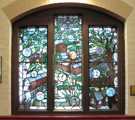Art & Design - church artifacts

Windows
Stained glass first appeared in churches in the 12th and 13th centuries. Their purpose was to both teach people and make the building look more beautiful. The windows told stories from the Bible and in the days when people couldn’t read, it was a way of them knowing and understanding a Bible story.
Stained glass changes all the time according to the light conditions. It can often cast brilliant patterns of colour on the pillars or other surfaces.
Stained glass windows were made by fitting pieces of glass into a network of leads. The pattern was drawn out on a large table and the window was built up slowly sliding the glass into place.
The main colours in early medieval windows are deep red, deep blue, deep green and golden yellow.
Why do you think these colours were used?
| |
 |
This window – 19th Century - shows the ascension of Christ – when he returned to heaven 40 days after his resurrection. The smaller windows at the top (traceries) show angels playing musical instruments and the lower part shows people watching as Christ (in the middle panel) goes up (ascends) to heaven. |
The 2 panels of this window show Jesus being baptised by John the Baptist. Above Jesus is a dove. The Holy City (‘heaven’ for many Christians) is shown across the top of both windows with an angel above. |
 |
|
Some stained glass in churches is more contemporary and reflects links with the local community.
Bramley Apple window in Southwell Minster
The first Bramley apple tree grew from pips planted by a young girl called Mary Ann Brailsford in Church Street, Southwell in 1809. Mr Matthew Bramley bought the house some time later and said that if the apples were ever commercialised they should bear his name! 200 years after the first tree grew, this window was made and placed in the Minster at Southwell. This shows how sometimes churches choose to have a window in the church that makes a link with a part of the local community or links back to local history.
Mining window in St. Mark's, Bestwood

This window was created as a Millennium window in a church in a coal mining community. It shows the industrial past of the village. The main features of the window are the engine house and headstocks, the miners’ houses, the lodge, the school, and lakes. There are nine roundels within the window, five of which were designed by children from the local school, showing the school badge, the war memorial, the graveyard and church. Another has a pick-axe and coal, a bridge with ducks and trees, and another, birds. The remainder of the roundels depict the local Male Voice Choir, the brass band, a Coat of Arms and a drawing of cotton flax, representing the former cotton mills.
This window is a good example of how the church and the local community are connected.
|